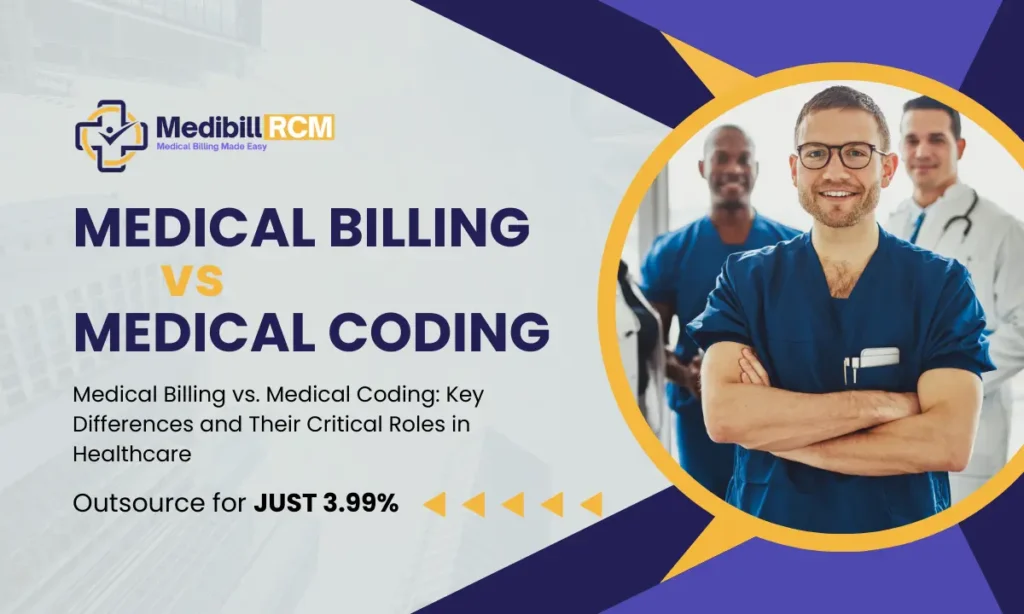Medical billing and medical coding are essential components of the healthcare revenue cycle. While both involve processing patient information for insurance claims, their roles differ significantly. Medical coding focuses on translating healthcare services into standardized codes, whereas medical billing ensures claims are submitted and reimbursed correctly.
Struggling with Revenue Leaks? Discover How Accurate Coding & Billing Can Increase Your Collections by 30%!
[Get a Free Revenue Cycle Audit]
Table of Contents
What is Medical Coding? The Backbone of Healthcare Documentation
Medical coding converts medical diagnoses, procedures, and services into standardized alphanumeric codes. It ensures consistency in records, simplifies insurance claims, and supports medical research and analytics.
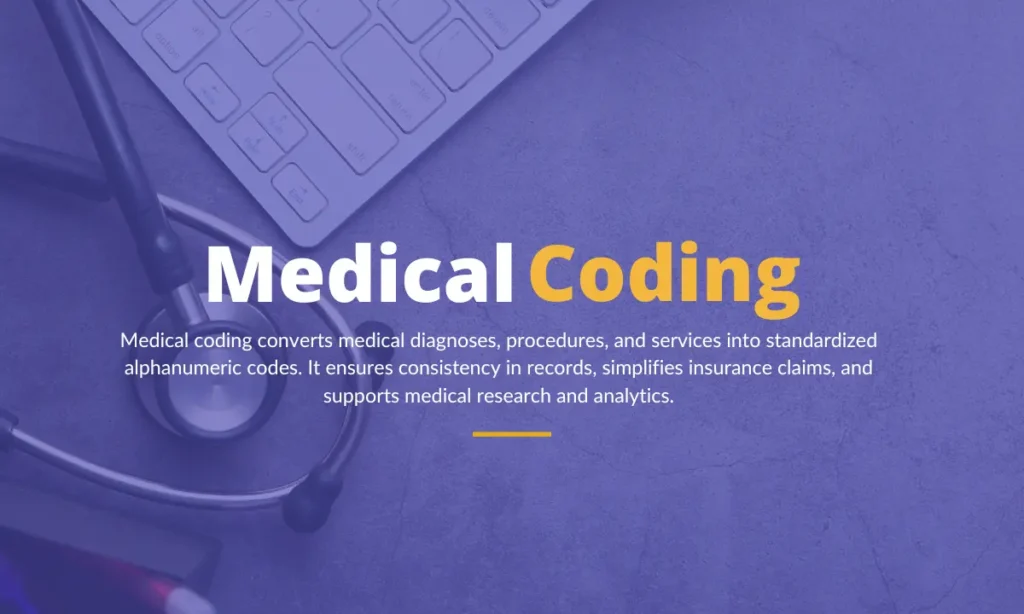
Core Purpose: Translating Medical Services into Universal Codes
Medical coding ensures accurate documentation of healthcare services using globally recognized classification systems, including:
- ICD-10 (International Classification of Diseases, 10th Revision) – Identifies medical conditions.
- CPT (Current Procedural Terminology) – Describes medical procedures and services.
- HCPCS (Healthcare Common Procedure Coding System) – Covers medical equipment, outpatient services, and Medicare-related billing.
- DRG (Diagnosis-Related Groups) – Categorizes hospital cases for reimbursement and resource management.
Key Responsibilities of a Medical Coder
Medical coders extract relevant details from patient records and assign correct codes. Their responsibilities include:
- Reviewing Clinical Documentation: Analyzing physician notes, surgical reports, and lab results.
- Assigning Accurate Codes: Applying ICD-10, CPT, and HCPCS codes to diagnoses, treatments, and medical equipment.
- Ensuring Compliance: Following coding guidelines set by regulatory bodies like AAPC (American Academy of Professional Coders) and AHIMA (American Health Information Management Association) to avoid legal or financial risks.
Impact of Errors in Medical Coding
Incorrect coding can lead to serious consequences, including:
- Claim Denials: Insurance companies reject claims with incorrect or incomplete codes.
- Audit Risks: Inaccurate coding increases the chance of insurance provider or regulatory agency audits.
- Revenue Loss: Misapplied codes can result in underpayments, affecting healthcare providers’ financial stability.
Medical coding is a critical step in the revenue cycle. Medical Claim processing and reimbursements become inefficient without accurate coding, affecting both healthcare providers and patients.
What is Medical Billing? The Engine of Healthcare Reimbursement
Medical billing is submitting and managing insurance claims to ensure healthcare providers receive proper service reimbursement. It bridges the gap between medical coding and financial transactions, making it a vital part of the healthcare revenue cycle.
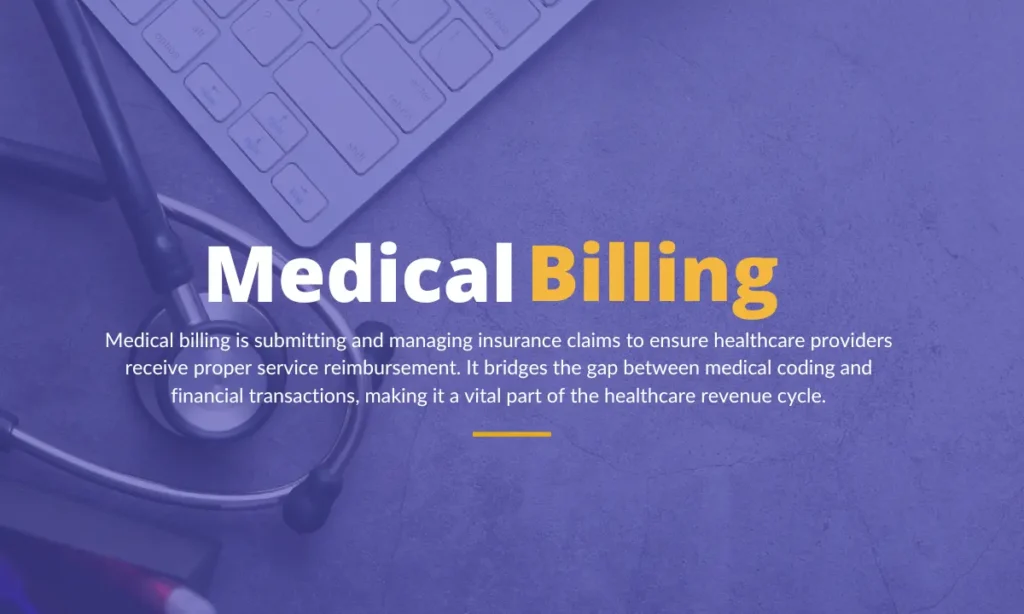
Core Purpose: Submitting and Managing Insurance Claims for Payment
Medical billing translates coded medical data into financial claims submitted to insurance companies. This process ensures that healthcare providers get paid accurately and promptly for their treatments and services.
Key Responsibilities of a Medical Biller
Medical billers handle various administrative and financial tasks, including:
- Preparing Claims: Compiling medical codes and patient details into standardized forms like:
- CMS-1500 (used for outpatient and professional services).
- UB-04 (used for hospital and institutional billing).
- Tracking Claim Status: Monitoring submitted claims, identifying rejected, and ensuring timely processing.
- Resolving Denials and Appeals: Investigating claim rejections, correcting errors, and filing appeals with insurance providers.
- Coordinating with Patients: Managing patient billing inquiries, explaining insurance coverage, and collecting outstanding balances.
Impact of Errors in Medical Billing
Mistakes in medical billing can cause significant financial and operational issues, including:
- Delayed Payments: Incorrect or incomplete claims result in payment delays, affecting cash flow.
- Patient Dissatisfaction: Billing errors, unexpected charges, or miscommunications can lead to frustration and disputes.
- Compliance Penalties: Non-adherence to insurance regulations, such as HIPAA (Health Insurance Portability and Accountability Act), can result in fines or audits.
Medical billing ensures that healthcare providers receive compensation for their services while maintaining compliance with insurance policies. Providers and patients face unnecessary financial stress without an efficient billing system.
Learn More About: 10 Common Reasons for Medical Billing Denials
Medical Billing vs. Medical Coding: A Side-by-Side Comparison
Medical billing and coding are closely linked but serve different roles in the healthcare revenue cycle. Coders handle clinical documentation, while billers manage financial transactions.
For practices, proper provider credentialing (like obtaining an NPI) is essential before billing or coding can begin. Knowing these differences highlights their unique contributions to healthcare administration.
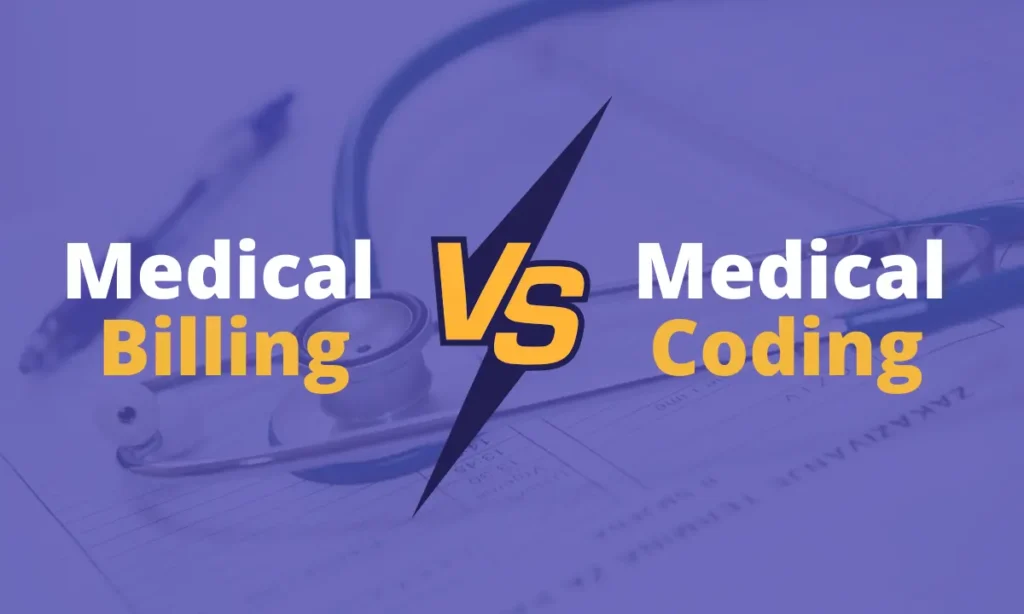
Differences in Focus
| Aspect | Medical Coding | Medical Billing |
|---|---|---|
| Primary Role | Converts healthcare services into standardized codes. | Submits claims and ensures providers receive payments. |
| Key Focus | Clinical accuracy and documentation. | Financial workflows and payer policies. |
| Main Objective | Ensures proper classification of diagnoses, treatments, and procedures. | Ensures claims are processed, approved, and reimbursed. |
| Regulatory Compliance | Follows coding guidelines (ICD-10, CPT, HCPCS) for accuracy and compliance. | Follows insurance policies (Medicare, Medicaid, private insurers). |
Medical coders ensure that claims contain the correct medical information, while billers ensure those claims result in proper reimbursement.
Tools & Technology Used
| Role | Tools & Software |
|---|---|
| Coders | – EHR Systems (Electronic Health Records) for accessing patient data. – Encoder Software (e.g., 3M, Optum360) for code lookup. – Computer-Assisted Coding (CAC) to improve accuracy. |
| Billers | – Billing Platforms (e.g., Kareo, AdvancedMD) to manage claims. – Clearinghouses (e.g., Availity, Change Healthcare) to process insurance claims. – Denial Management Tools to track and appeal rejected claims. |
Coders and billers rely on different technologies, but both use EHR systems to access patient records efficiently.
Learn More About: Top 10 EHR and Billing Software
Career Pathways in Medical Billing and Coding
| Career Aspect | Medical Coders | Medical Billers |
|---|---|---|
| Required Skills | Analytical skills, attention to detail, medical terminology knowledge. | Strong communication skills, knowledge of insurance regulations, and financial expertise. |
| Certifications | – CPC® (Certified Professional Coder) – AAPC – CCS (Certified Coding Specialist) – AHIMA | – CPB™ (Certified Professional Biller) – AAPC – CMRS (Certified Medical Reimbursement Specialist) – AMBA |
| Career Growth | Opportunities in specialized coding (oncology, radiology, risk adjustment). | Advancement into revenue cycle management, healthcare administration. |
Medical coding requires in-depth knowledge of medical terminology, while medical billing demands financial and insurance expertise. Many professionals start in one field and later cross-train to expand their career options.
Synergy in the Revenue Cycle: Why Both Are Non-Negotiable
Medical billing and medical coding are inseparable components of the healthcare revenue cycle. Coders ensure medical services are correctly documented, while billers ensure those services are reimbursed. Without precise coding, claims get denied. Without effective billing, providers face payment delays.
Interdependency Explained
| Role | Function | Impact on Revenue Cycle |
|---|---|---|
| Medical Coders | Assign accurate ICD-10, CPT, and HCPCS codes to diagnoses and procedures. | Ensures claims meet insurer requirements and avoid denials. |
| Medical Billers | Submit coded claims, follow up on payments, and manage denials. | Ensures providers receive timely reimbursement. |
Example of Collaboration
- A medical coder forgets to include a modifier on a procedure code.
- The insurance company rejects the claim due to incomplete coding.
- A medical biller identifies the issue and works with the coder to correct and resubmit the claim.
This process highlights the critical partnership between coding and billing to prevent revenue loss.
Revenue Cycle Workflow: Step-by-Step Process
Medical Coding:
- Patient encounters are documented.
- Coders assign standardized codes.
Claim Submission:
- Billers compile coded data into claim forms (CMS-1500, UB-04).
- Claims are submitted to insurance providers.
Payment Posting:
- Insurance reviews the claim and processes payment.
- Billers ensure payments match expected reimbursements.
Denial Management:
- Rejected claims are analyzed.
- Errors are corrected, and claims are resubmitted.
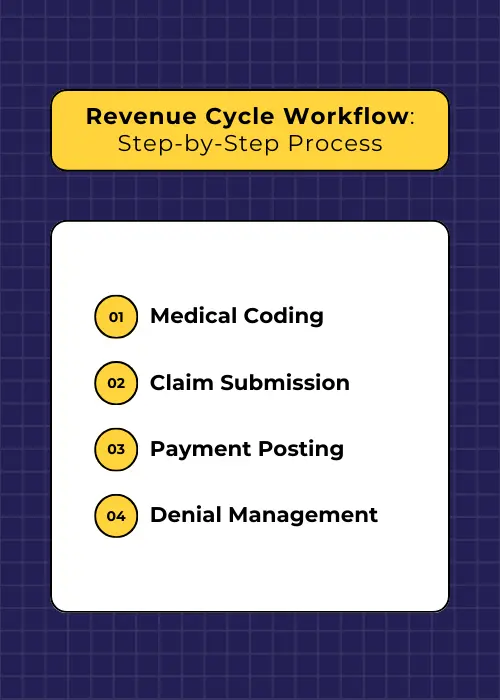
Real-World Impact: The Financial Benefits of Seamless Collaboration
When coders and billers work efficiently together, healthcare providers experience the following:
- 15-20% Revenue Boost: Correct coding and proactive billing reduce claim rejections.
- Faster Payments: Minimizing errors leads to quicker insurer reimbursements.
- Lower Administrative Costs: Fewer denied claims mean less time spent on appeals.
By aligning coding accuracy with billing efficiency, healthcare organizations maximize revenue while maintaining compliance.
Challenges in Medical Billing and Coding (And How to Solve Them)
Despite their importance in the healthcare revenue cycle, medical billing and coding have significant challenges. Errors, changing regulations, and payer-specific rules can lead to claim denials, revenue loss, and compliance risks. Addressing these issues requires a proactive approach and the right technology.
Common Pain Points in Medical Billing and Coding
| Challenge | Medical Coding Issues | Medical Billing Issues |
|---|---|---|
| Incomplete Documentation | Missing details from physicians can result in incorrect or incomplete codes. | Missing information can result in claim denials or underpayments. |
| Evolving Guidelines | ICD-10, CPT, and HCPCS codes are frequently updated, requiring coders to stay current. | Insurance policies, including Medicare and Medicaid rules, change regularly. |
| Timely Filing Limits | Delayed documentation slows down the coding process, leading to late claims. | Insurance companies enforce strict submission deadlines, causing denied claims if missed. |
| Payer-Specific Rules | Different insurers have unique coding requirements, increasing complexity. | Billing Companies must understand varying reimbursement policies to ensure correct payments. |
Learn More About: State-Specific Payer Credentialing Guide
Solutions to Overcome These Challenges
✅ Regular Coder-Provider Audits
- Conduct routine documentation reviews to ensure completeness and accuracy.
- Train providers on proper documentation practices to reduce coding errors.
- Use compliance audits to detect and correct potential billing and coding issues before submission.
✅ Automated Denial Management Systems
- Implement AI-driven claim scrubbing tools to detect coding and billing errors before submission.
- Use automated tracking systems to flag denied claims and prioritize corrections.
- Leverage predictive analytics to identify patterns in denials and proactively address recurring issues.
Proactive auditing and automation can reduce claim denials, improve accuracy, and speed up reimbursements. By integrating technology-driven solutions, healthcare providers can minimize financial losses and streamline their revenue cycle.
Technology’s Role: AI, Automation, and the Future

Advancements in technology are transforming medical billing and coding by improving accuracy, efficiency, and security. AI, predictive analytics, and blockchain are reshaping how healthcare providers manage claims and protect patient data.
AI-Powered Coding Assistants: Reducing Human Error in Code Assignment
Artificial Intelligence (AI) in medical coding enhances accuracy by automating code selection and minimizing errors. AI-powered coding tools analyze clinical documentation and suggest the most appropriate ICD-10, CPT, and HCPCS codes based on patient records.
Key Benefits:
- Error Reduction: AI detects inconsistencies, reducing claim denials caused by coding mistakes.
- Efficiency Boost: AI speeds up the coding process, allowing coders to focus on complex cases.
- Compliance Assurance: Machine learning models stay updated with evolving coding guidelines.
Example: AI-driven platforms like 3M™ M*Modal and Optum360® improve coding accuracy by analyzing real-time physician notes, reducing manual workload.
Predictive Analytics for Billing: Identifying Denial Trends Pre-Submission
Predictive analytics helps medical billers identify potential claim denials before submission. By analyzing past claim data, these systems detect patterns in insurance rejections, allowing proactive adjustments.
How It Works:
- Denial Prediction: AI flags claims that are likely to be denied based on payer-specific trends.
- Revenue Optimization: Providers can correct errors before submission, reducing financial losses.
- Automated Appeals: AI suggests appeal strategies based on past successful claim resubmissions.
Example: A 2023 HFMA report found that predictive analytics reduced denial rates by 27% in hospitals using automated claim review systems.
Blockchain & Security: Protecting Patient Data in Claims Processing
Blockchain enhances data security in medical billing by creating tamper-proof, decentralized records. Every transaction in the billing process is securely logged, preventing fraud and unauthorized access.
Why Blockchain Matters:
- Data Integrity: Immutable records ensure billing and coding accuracy.
- Fraud Prevention: Eliminates duplicate billing and unauthorized claim modifications.
- HIPAA Compliance: Ensures encrypted, secure transmission of patient data.
Example: Companies like BurstIQ and IBM Blockchain are implementing secure blockchain solutions to streamline medical claims and prevent fraud.
Emerging technologies are making medical billing and coding more efficient, accurate, and secure.
Learn More About: What is Medical Billing Outsourcing? Benefits & Challenges
Why Certification Matters: Building Credibility in Both Fields
Certification plays a crucial role in establishing credibility for medical coders and billers. Employers prefer certified professionals as they demonstrate expertise, compliance knowledge, and a commitment to industry standards.
Top Certifications
For Medical Coders:
- CPC® (Certified Professional Coder) – Offered by AAPC, focuses on physician-based coding.
- CCS (Certified Coding Specialist) – Provided by AHIMA, emphasizing inpatient and outpatient coding.
For Medical Billers:
- CPB™ (Certified Professional Biller) – AAPC certification specializing in claim submission and revenue cycle management.
- CMRS (Certified Medical Reimbursement Specialist) – AMBA certification covering insurance and reimbursement policies.
Learn More About: Rendering Provider vs Billing Provider
Salary Benchmarks (2025)
Certifications directly impact earning potential, with certified professionals earning significantly more than non-certified counterparts.
| Role | Average Salary (2025) | Higher-End Earnings (Experience & Specialization) |
|---|---|---|
| Certified Medical Coder | $60,000+ annually | $75,000+ (with specialty coding, e.g., oncology, risk adjustment) |
| Certified Medical Biller | $58,000+ annually | $70,000+ (with extensive payer knowledge and appeals expertise) |
According to AAPC’s 2025 Salary Report, certified coders earn 22% more than non-certified coders, and billers with advanced credentials secure better job stability and salaries.
🚀 “Streamline Your Revenue Cycle with Expert Medical Billing, Coding & Credentialing Services!
✅ 97% Claim Accuracy | ✅ Faster Reimbursements | ✅ Certified Specialists
[Get a Free Practice Audit Today]
Medical Billing vs. Medical Coding – FAQ’s
Can One Professional Handle Both Roles?
Yes, but mainly in small practices. More extensive healthcare facilities separate medical billing and coding to improve accuracy, efficiency, and compliance. Specialization reduces claim denials and ensures proper reimbursement.
Which Career Has Better Growth: Medical Billing or Coding?
Medical coding offers better long-term growth due to specialization in inpatient coding, auditing, and risk adjustment. However, experienced medical billers with expertise in denial management and revenue cycle optimization also have substantial career advancement opportunities.
How Do Both Roles Improve Patient Care?
Accurate coding ensures correct diagnoses and treatments are documented, leading to fewer claim rejections. Efficient billing ensures timely reimbursements, reducing financial stress on patients and allowing healthcare providers to focus on care.
Which Pays More: Certified Medical Coding Specialist vs. Medical Billing?
Certified medical coders earn slightly more, with an average salary of $60,000+, reaching $75,000+ in specialized fields like oncology or risk adjustment. Certified medical billers earn around $58,000+, with experienced professionals in revenue cycle management making $70,000+ annually.
Medical Billing and Coding – Two Pillars of Healthcare Success
Medical billing and coding are essential to the healthcare system, ensuring accurate documentation, timely reimbursements, and regulatory compliance. Coders translate medical services into standardized codes, while billers handle claims processing and payment coordination. Together, they support a smooth revenue cycle and minimize financial risks for providers.
Final Takeaway
Both roles are crucial for financial stability in healthcare. Proper coding reduces claim denials, and efficient billing ensures timely payments. Healthcare providers can optimize operations and reduce administrative burdens by outsourcing to experts like MediBill RCM LLC.
Related Posts

